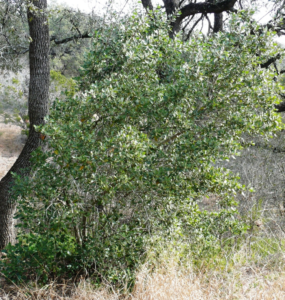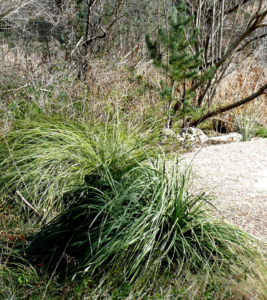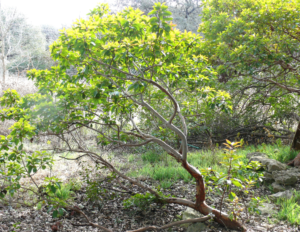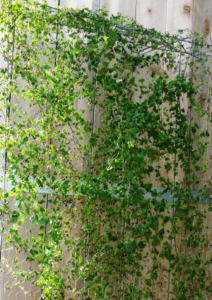Author: Bill Ward
Last weekend after the temperature in our yard dropped to 12 degrees one night and 16 the next night, I was lamenting about having to look out on a desolate brown yard for several weeks until spring arrives. It was a nice surprise, however, to see that a lot of our native shrubs and even some forbs and vines survived without much damage, despite so many hours below freezing. Some parts of our yard hardly show we just came out of the coldest spell in many years.

Among our still-green shrubs and small trees are Texas mountain laurel (Sophora secundiflora), evergreen sumac (Rhus virens), Texas madrone (Arbutus xalapensis), cenizo (Leucophyllum sp), mountain cedar (Juniperus ashei), autumn sage (Salvia greggii), silktassel (Garrya ovata subsp. lindheimeri), agarita (Berberis trifolata), barberry (Berberis swaseyi), Texas pistache (Pistacia texana), wax myrtle (Myrica cerifera), condalia (Condalia hookeri), damianita (Chrysactina mexicana), piñon pine (Pinus cembroides), and palmetto (Sabal minor).

The mountain laurel, evergreen sumac, and silktassel show that in this part of the Hill Country it’s possible to have an evergreen hedge or privacy screen without planting the exotic ligustrum or red-tipped photinia.
Our little Vasey oaks (Quercus pungens var. vaseyana) proved to be as “evergreen” as the live oak trees (Quercus fusiformis).
Neither beargrass (Nolina texana) nor devil’s shoestring (Nolina lindheimeriana) was fazed by the frigid weather. The sotol (Dasylirion texanum) and our various agaves, yuccas, and cactuses are still green, too.

Even some of our maidenhair fern (Adiantum capillus-veneris) received only minor damage during the deep freeze. The fern already had withstood December lows in the mid-twenties without turning brown at all. Perhaps that is because it grows under protecting branches of a large live oak, but even under the oak it was unusually cold last weekend.
Among our native vines that still have green leaves are crossvine (Bigonia capreolata), old man’s beard (Clematis drummondii), Carolina jessamine (Gelsemium sempervirens), and much to my surprise, snapdragon vine (Maurandya antirrhiniflora).

A seemingly cold-hardy native plant I’m trying to get started in my yard is cut-leaf germander (Teucrium laciniatum). This perennial wildflower still had a couple of blooms late last month, and the recent cold spell seems to have done little harm to the leaves. It looks as if this is going to be a good garden plant.
Other forbs that did not freeze back to the ground are violets (Viola missouriensis), blue-curls (Phacelia congesta), columbine (Aquilegia canadensis and A. hinckleyana), and slender-stem bitterweed (Perityle lindheimeri). And all our bluebonnet rosettes survived. It’s going to be a good bluebonnet year!
With so many native plants that hold on to their leaves in sub-freezing weather, we can keep a lot of green in our Hill Country landscapes, even during the colder winters.


